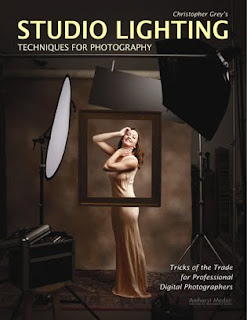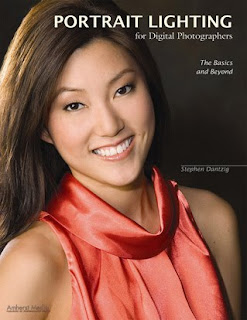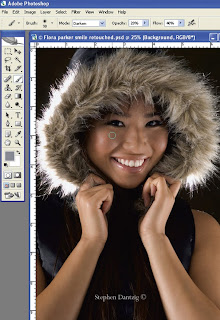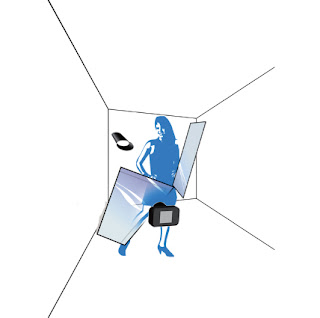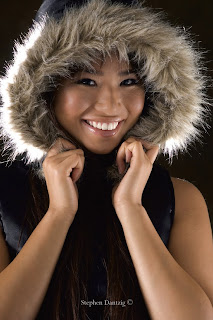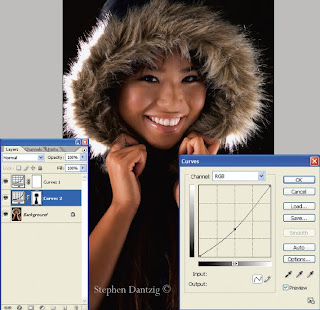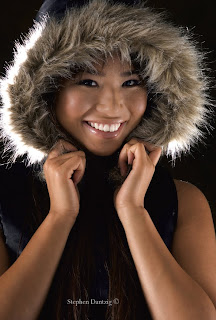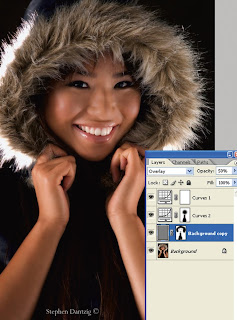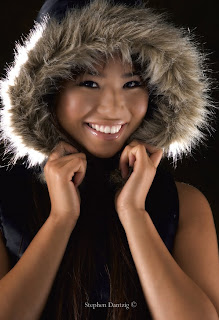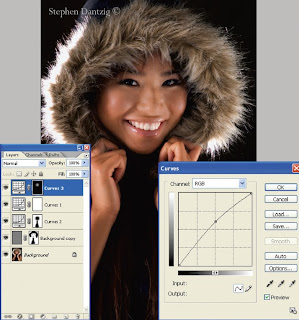 Today's post comes from the book Jeff Smith's guide to Head and Shoulders Portrait Photography. It is available from Amazon.com and other fine retailers.
Today's post comes from the book Jeff Smith's guide to Head and Shoulders Portrait Photography. It is available from Amazon.com and other fine retailers.One of the biggest misconceptions about head and shoulders portraits is that very little posing is needed to create a beautiful, salable portrait. In fact, you must select a pose that coordinates with the lighting, background, and clothing to produce a look that will fulfill the client’s needs and desires. On top of that, your posing must hide (or at least lessen) the obvious flaws that your client wouldn’t want to see. Before we get into corrective posing, however, we’ll review the basic components that go into a flattering pose.
Posing is a study of the human form that never ends, because it is a study that is always changing. From my experience, the photographers who have the hardest time creating poses that meet clients’ expectations are the young photographers and the older, “well seasoned” photographers. Both tend to pose a client to meet their own expectations and not the client’s. If you pose clients in this way, they will never be as happy as they could be, and you will never profit as much as you could by learning to pose for the client and not yourself.
The Head and Face
The Face Turned Toward the Main Light. I work with a lighting ratio that is approximately 2:1 or 3:1 without diffusion, and 4:1 with diffusion. This means that if the face is turned away from the main light, the shadow on the side of the nose will increase, making the
nose appear larger.
If, instead, you turn the face toward the main-light source, whether in the studio or outdoors, you light the mask of the face without increasing shadowing in areas of the face where it shouldn’t be. An added bonus is that turning the head also stretches out the neck and reduces the appearance of a double chin, if the subject has one. (Note: Decreasing the lighting ratio also reduces unflattering shadows, but it produces a flat look in the portrait. I call this “mall lighting,” because the inexperienced photographers employed by most national and mall photography studios tend to use this very flat lighting to avoid shadows if the face isn’t posed properly.)
Lower the Chin, Lose the Catchlights. Lowering the chin produces a more attractive angle of the face, but also requires lowering the main light to compensate. If you don’t, you’ll lose the catchlights—the single most important aspect of a portrait (from a lighting standpoint). I suggest you elevate the main light to a point where it is obviously too high (with no apparent catchlight) and then slowly lower it until the proper lighting effect is achieved. This forces you to adjust the light with each pose.
The Position of the Eyes. There are two ways to control the position of the eyes in a portrait. First, you can change the pose of the eyes by turning the subject’s face. Second, you can have the subject change the direction of their eyes to look higher, lower, or to one side of the camera.
Typically, the center of the eye is positioned toward the corner of the eye opening. This enlarges the appearance of the eye and gives the eye more impact. This is achieved by turning the face toward the main light while the eyes come back to the camera. This works well for all shapes of eyes, except for people with bulging eyes. When this is done on bulging eyes, too much of the white will show and draw attention to the problem.
 The center of the eye is positioned toward the corner of the eye opening to enlarge itsappearance and give the eye more impact.
The center of the eye is positioned toward the corner of the eye opening to enlarge itsappearance and give the eye more impact. The point at which you ask the subject to focus their gaze in respect to the position of the camera’s lens also, in essence, poses the eye. As I’ve already mentioned, the subject should always be looking at someone, not something. To do this, I put my face where I want their eyes to be. There is a certain spark that the eyes have when they look into someone else’s eyes that they don’t have when they are looking at a spot on the wall or a camera lens.
Usually, I position my face directly over the camera. This puts the eyes in a slightly upward position, increasing the appearance of the catchlights. If the camera position is too high to make this possible, I position my face on the main-light side of the camera, never beneath it and never to the shadow side of it. Both would decrease the catchlights.
With my face directly to the side of the camera, the eyes appear to be looking directly into the lens, even though the subject is actually looking at me. When looking from the side of the camera, a common mistake that my new photographers make is getting their face too far from the camera. This makes the eyes of the subject appear to be looking off-camera—which is fine if that is the intention and not a mistake.
When the eyes of the subject look into the lens (or very close to it), the portrait seems to make eye contact with the viewer. This type of portrait typically sells better than portraits that have the subject looking off-camera in a more reflective pose. Reflective posing does, however, work in a storytelling portrait—a bride glancing out a window as if waiting for her groom, a senior glancing over the top of a book and thinking of the future, new parents looking down at their baby and thinking of how many diapers they are going to have to change before that kid is potty trained. Well, maybe not that last one—but you get the picture.
If the eyes are to look away from the camera, there a few rules that need to be followed. They are really simple rules, but ones that I see broken often. First, the eyes should follow the same line as that of the nose. It looks ridiculous to have the eyes looking in a different direction than the nose is pointing. This goes for poses with the subject looking just off-camera, as well as for complete profiles. Second, as you turn the face away from the camera, there comes a point where the bridge of the nose starts to obscure the eye farthest from the camera. At this point, you have gone too far. Either you go into a complete profile, that so many photographers leave school doing so badly. I have seen everything from young ladies who look completely awkward, to guys who look like they were just involved in a car crash that broke their neck.
The Tilt of the Head. How I wish that every college teaching photography would just avoid this one subject. I have never seen one aspect of photography that so many photographers leave school doing so badly. I have seen everything from young ladies who look completely awkward, to guys who look like they were just involved in a car crash that broke their neck.
Which direction and how far to tilt the head must be decided on an individual basis.
The Traditional Rules. While many college students will accept that there are different ways to light, pose, and photograph a subject, a lot of them are convinced that there is only one way to tilt the head of each gender—and it’s precisely the way their teacher told them! I have had some truly talented photographers work for me, and that is the one obstacle I have had to overcome with almost every one of them.

The only difference between these two portraits is the tilt of the subject’s head—but what a difference it makes!

Which of the above photographs do you like better? If you are like all the people I showed these photographs to, you would say the one on the right. Well, there goes the classic theory of posing shot right in the keister! According to that theory, a woman is always supposed to tilt her head toward her higher shoulder. In this case, tilting the head toward the higher shoulder made her look as though she just sat on a very sharp object and is waiting until we take the picture to get the heck off of it. By tilting the head into what traditionalists consider a “man’s” pose, we made her look confident, beautiful, and nothing like a man.
The Real Rule. Now that I have had a little fun, I can continue. The real rule of tilting the head is that there is no rule. You don’t always do anything in photography. If you are photographing a woman, you don’t tilt toward the high shoulder and you don’t tilt toward the low shoulder, you tilt toward the shoulder that looks good.

Long Hair. When photographing a woman with long hair, I look to the hair and not the gender to decide the direction the head will be tilted and the direction in which the body will be placed. Long hair is beautiful, and there must be an empty space to put it. A woman’s hair is usually thicker on one side of her head than the other. The tilt will go to the fuller side of the hair and the pose will create a void on the same side for it to drape into. This means she will sometimes be tilting toward the lower shoulder.

For the Guys. Guys typically aren’t gender benders when it comes to posing; they usually do look better tilting the head toward the lower shoulder or not tilting at all. Again, the pose and the circumstance dictate the direction the head is tilted or whether it is tilted at all.
The easiest way to learn about the head tilt is to first pose the body. Then, turn the face to achieve the perfect lighting and look. Then stop. If the person looks great (as about 80 percent of clients do), take the image. If the subject is very uncomfortable and starts tilting their head in an awkward direction, correct it. It’s that simple.
The Neck. The neck really isn’t posed and it really isn’t part of the face, but there are a few points that should be shared about this area. First of all, the neck is the first to show weight gain and age. In many clients, as you turn the face toward the light, the little cord-like tendons pop out, making the subject look like Jim Carrey doing his FireMarshall Bob routine on In Living Color (if you don’t happen to be familiar with the character, then trust me—it’s not an appealing or flattering look). The best way to handle the neck area is to cover it up with clothing. If this isn’t possible, use a pose that obscures this area from view. (These same neck-hiding poses—several are seen on the previous page—will also conceal a double chin, which can be very helpful.)
BUY THIS BOOK FROM AMAZON

























